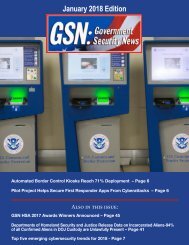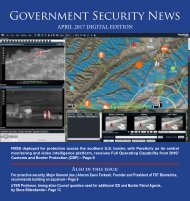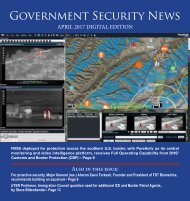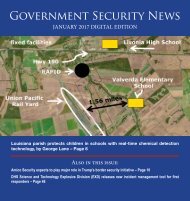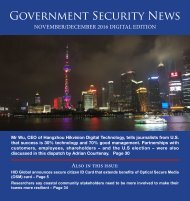Government Security News February 2017 Digital Edition
Create successful ePaper yourself
Turn your PDF publications into a flip-book with our unique Google optimized e-Paper software.
that might prevent deportation. For<br />
those who are traumatized from<br />
their journey or harm they fled,<br />
the short timelines can make it extremely<br />
difficult to clearly explain<br />
why they need protection in the<br />
United States.<br />
The abbreviated process increases<br />
the likelihood that a person who is<br />
not supposed to be subject to expedited<br />
removal—such as a U.S. citizen<br />
or LPR—will be erroneously removed.<br />
Moreover, individuals who<br />
otherwise would be eligible to make<br />
a claim for “relief from removal”<br />
(to argue they should be permitted<br />
to stay in the United States) may be<br />
unjustly deprived of any opportunity<br />
to pursue relief. For example, a<br />
witness or victim of a crime might<br />
be eligible for status but is prohibited<br />
from making such a claim in<br />
expedited removal proceedings.<br />
Inadequate Protection<br />
of Asylum Seekers<br />
In practice, not all persons expressing<br />
a fear of persecution if returned<br />
to their home countries are provided<br />
a credible or reasonable fear screening.<br />
Studies by the U.S. Commission<br />
on International Religious Freedom<br />
(USCIRF) noted that, in some cases,<br />
immigration officers pressured<br />
individuals expressing fear into<br />
withdrawing their application for<br />
admission—and thus their request<br />
for asylum—despite DHS policies<br />
forbidding the practice. In other<br />
cases, government officers failed to<br />
ask if the arriving individual feared<br />
return. In addition, the Commission<br />
found that the government did<br />
not have sufficient quality assurance<br />
mechanisms in place to ensure that<br />
asylum seekers were not improperly<br />
being turned back.<br />
A Growing Backlog of<br />
Asylum Applications<br />
Individuals expressing fear of return<br />
who are diverted from expedited<br />
removal are referred to asylum officers<br />
for screening. These officers<br />
are often the same corps handling<br />
affirmative asylum applications (i.e.,<br />
cases filed by individuals not in removal<br />
proceedings). Since these<br />
asylum seekers are detained pending<br />
completion of the credible or<br />
reasonable fear process, their cases<br />
are prioritized by the government.<br />
Asylum Office resources are therefore<br />
diverted to these interviews,<br />
contributing to the backlog of affirmative<br />
asylum cases.<br />
Further expansion of expedited<br />
removal will require significantly<br />
more asylum officers, or the backlog<br />
of affirmative asylum cases will<br />
continue to grow. This workload<br />
management crisis could be avoided<br />
35<br />
entirely if DHS personnel placed all<br />
asylum seekers apprehended at the<br />
border in regular immigration court<br />
proceedings and paroled them<br />
pending their hearings. Providing<br />
the immigration court system with<br />
enough funds to sufficiently staff<br />
immigration judge teams would<br />
help ensure that asylum seekers get<br />
a prompt court hearing.<br />
FREE SUBSCRIPTION<br />
SIGN-UP<br />
Monthly <strong>Digital</strong> <strong>Edition</strong><br />
Airport/Seaport <strong>News</strong>letter<br />
Daily Insider <strong>News</strong>letter<br />
Cybersecurity <strong>News</strong>letter<br />
CLICK HERE




